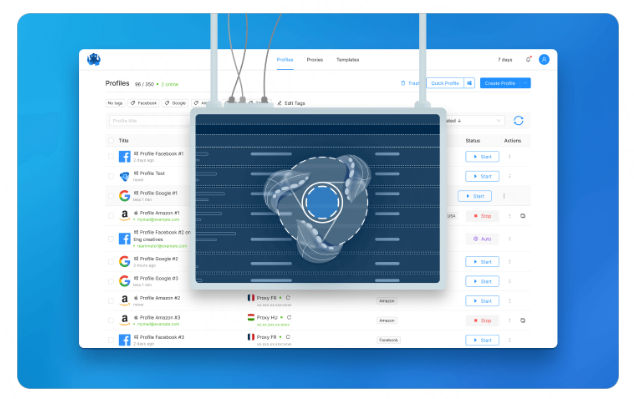
आवासीय प्रॉक्सीज़ ने 23 अप्रैल को 220,000 यूएस आईपी जोड़े।


AI वेब डेटा स्क्रैपिंग अनन्य प्रॉक्सी योजना [ असीमित ट्रैफ़िक, 100G+ बैंडविड्थ ]

 Language
Language

Why are most anti-detect browsers for multi-accounting built on similar source codes? How does Chromium track and identify users by their digital fingerprint? Which elements must be removed from Chromium to ensure better privacy and anonymity? The Octo Browser Team answers the most popular questions about browsers for multi-accounting.
A browser is a software application designed for accessing web pages. Once a user wants to visit a particular website, the browser searches for its hosting server and initiates a connection. Afterward, the browser sends an HTTP request to the server. It receives a response that includes the site's content, cookie data, and caching methods. Once these data elements are received, the browser processes them to render the web page.
The browser interface facilitates user control and consists of navigation buttons, a search field, bookmarks, settings, windows, and other elements—everything except for the website content itself. The core of a browser is its engine, which translates the code containing the website's content and formatting details into an easy-to-read web page. The browser and its engine are intertwined like a car's pedals and engine: the browser allows you to navigate the "machine" performing all necessary calculations, rendering, file downloads, and more—everything operating "under the hood." The outcome of these processes appears as the web pages you view.
Here are some popular browsers and their engines:
Google Chrome, Opera - Blink
Mozilla Firefox - Gecko
Safari - WebKit
Browsers also have a network subsystem, which handles network requests, and a storage subsystem, where they store bookmarks, cookies, and settings.
Chromium is an open-source browser based on the Blink engine. It's the backbone of numerous well-known browsers, such as Google Chrome, Microsoft Edge, Opera, Brave, Vivaldi, and others. The framework powers web page rendering across these platforms. Besides having one core, each browser has unique privacy and security settings, ad blockers, customizable interfaces, page-loading accelerators, torrent clients, etc.
Browsers built on Chromium differ from visual interface elements to the media formats they support by default. For instance, Google Chrome provides native support for popular audio formats like MP3 and AAC. At the same time, Chromium does not include these by default. Furthermore, Chromium is less connected to Google: it does not send error reports, statistics, or RLZ identifiers and doesn't work with Google Updater for automatic updates.
The key reason lies in its open-source nature, which allows developers to modify, add, remove, or fine-tune any browser element. Chromium's components are present not only in browsers but also in services like Spotify. With support from the open-source community and big corporations, Chromium's source code is constantly updated—errors are fixed, and useful features are added, which makes it a powerful asset for developers
Thanks to its multi-process architecture, Chromium is a robust browser functionally. It ensures stability, efficiently clears RAM when applications are closed, and minimizes the use of system resources.
Chromium's architecture and streamlined source code also improve its performance. Moreover, Crankshaft technology enhances the performance of complex JavaScript applications.
Running on the Blink engine, Chromium complies with roughly 95% of web standards, including HTML 4.01, XML 1.0 (4th edition), and xHTML 1.0 (2nd edition), while support for HTML5 and CSS3 is continually evolving.
Chromium also supports extensions, allowing interactions with tabs, bookmarks, context menus, and more through a native API.
Octo Browser also uses Chromium as its base. Its popularity allows the multi-accounting browser to blend in seamlessly with the crowd. According to SimilarWeb data, Google Chrome holds about 65% of the browser market, followed by Safari at 22.8%. However, Safari’s proprietary nature makes it unsuitable for multi-accounting browser development, leaving Chromium the optimal choice for compatibility and anonymity.
Octo Browser mimics Google Chrome, making it nearly indistinguishable from websites and security systems from Chrome. The Octo team updates the Octo Browser within days of each Chrome release to ensure its users’ digital fingerprints remain aligned with Chrome users, who benefit from Chrome’s automatic updates.
Despite its resemblance to Chrome, Octo Browser does not include Google tracking components like RLZ, histograms, UMA metrics, or other tools. Features that connect Chrome to Google’s services (such as cloud-based password management and synchronization) have also been removed. This results in a Chromium-based browser stripped of Chrome’s tracking mechanisms but functionally identical to Chrome from a website’s perspective.

Octo Browser developers implemented essential anti-detection and multi-accounting features to the “de-Googled” Chromium version. These include detailed fingerprint customization, allowing users to tweak over 50 settings or create profiles in a single click, automatically generating fingerprints. Another key feature is the ability to connect individual proxies to each profile. Octo Browser is optimized to handle large numbers of profiles. It includes API automation tools, collaborative features, cookie management, video stream spoofing, and more. These tools enable users to create isolated profiles for websites and services, ensuring that tracking scripts cannot connect actions across profiles.
Most multi-accounting anti-detect browsers are built on Chromium due to its open-source nature, strong performance, and security. Chromium’s popularity, mainly due to Chrome’s large user base, allows these browsers to blend into a more extensive user pool.
Octo Browser removes all links to Google’s services. It is optimized to handle multiple profiles efficiently. It includes advanced features like proxy management, teamwork capabilities, the Cookie Robot, video stream spoofing, and more.
If you're ready to get started, Octo Browser offers an exclusive promo
code LUNAPROXY for a free 7-day Base subscription. Test its advanced
features and discover why it's trusted by professionals worldwide!
